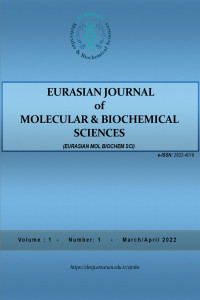Genetic diversity of Galeodes populations (Arachnida: Solifugae) on Bolkar Mountains
Genetic diversity of Galeodes populations (Arachnida: Solifugae) on Bolkar Mountains
Bolkar Mountains, Galeodes RAPD-pcr, Solifugae,
___
- 1. Wharburton C. Arachnida-Elasmobranchiata, Scorpions, Spiders, Mites, Ticks, etc. In “The Cambridge Natural History” (Eds. S.F. Harmer and A.E. Shipley). MacMillan and Co., Limited. London, 1909. pp. 297-474.
- 2. Harvey MS. The neglected cousins: what do we know about the smaller arachnid orders? J Arachnol 2002; 30: 357-372.
- 3. Blick T, Harvey M. Worldwide catalogues and species numbers of the arachnid orders (Arachnida). Arachnol Mitt 2011;41: 41-43.
- 4. Karataş A, Uçak M. A new Barrussus Roewer, 1928 (Solifugae: Karschiidae) from Southern Turkey. Turk J Zool 2013; 37(5):594-600.
- 5. Harvey MS. Catalogue of the Smaller Arachnid Orders of the World. Amblypygi, Uropygi, Schizomida, Palpigradi, Ricinulei and Solifugae. Csiro Publishing, Collingwood, Victoria, Australia, 2003. pp. 385.
- 6. Bird TL, Wharton RA, Prendini L. Cheliceral morphology in Solifugae (Arachnida): primary homology, terminology and character survey. Bull Am Mus Nat Hist 2015; 394: 1-355.
- 7. Wheeler WC, Hayashi CY. The phylogeny of the extant Chelicerate orders. Cladistics 1998;14: 173-192.
- 8. Shultz JW. A phylogenetic analysis of the arachnidorders based on morphological characters. Zool J Linn Soc 2007; 150: 221–265.
- 9. Dabert M, Witalinski W, Kazmierski A, Olszanowski Z, Dabert J. Molecular phylogeny of acariform mites (Acari, Arachnida): Strong conflict between phylogenetic signal and long-branch attraction artifacts. Mol Phylogenet Evol 2010; 56 (1): 222-241.
- 10. Pepato AR, da Rocha CE, Dunlop JA. Phylogenetic position of the acariform mites: sensitivity to homology assessment under total evidence. BMC Evol Biol. 2010;10, 235.
- 11. Arabi J, Judson MLI, Deharveng L, Lourenço WR, Cruaud C and Hassanin A.. Nucleotide Composition of CO1 Sequences in Chelicerata (Arthropoda): Detecting New Mitogenomic Rearrangements. J. Mol. Evol. 2012;74: 81-95.
- 12. Giribet G, Edgecombe GD. Reevaluating the arthropod tree of life. Annu Rev Entomol 2012; 57: 167–186.
- 13. Masta SE, Klann AE, Podsiadlowski L. A comparison of the mitochondrial genomes from two families of Solifugae (Arthropoda: Chelicerata): Eremobatidae and Ammotrechidae. Gene 2008; 417: 35-42.
- 14. Maddahi H, Khazanehdari M., Aliabadian M., Gholi Kami H., Mirshamsi A., Mirshamsi O. Mitochondrial DNA phylogeny of camel spiders (Arachnida: Solifugae) from Iran. Mitochondrial DNA Part A 2017; 28:6, 909-919.
- 15. Santibáñez-López CE, Farleigh K, Cushing PE, Graham MR. Restriction enzyme optimization for RADseq with camel spiders (Arachnida: Solifugae). J Arachnol 2021; 48(3):346-350.
- 16. Santibáñez-López CE, Cushing PE, Powell AM, Graham MR. Diversification and post-glacial range expansion of giant North American camel spiders in genus Eremocosta (Solifugae: Eremobatidae). Sci Rep 2021; 11:1-11.
- 17. Roewer CF. Solifugae, Palpigradi. In: Klassen und Ordnungen des Tierreichs. 5: Arthropoda. IV: Arachnoidea, (Ed. H.G. Bronn), Akademische Verlagsgesellschaft M.B.H., Leipzig; 1934. pp. 481-608.
- 18. El-Hennawy HK. Sun-spiders of Turkey (Arachnida: Solpugida), list of species and key to genera. Serket 2007; 10 (4); 130-134.
- 19. Erdek M. A new species of the solifuge genus Galeodes Olivier, 1791 from southeastern Turkey (Solifugae, Galeodidae). Zootaxa 2021; 4991(1):116-130.
- 20. Altın BN, Altın T. Niğde’nin Fiziki Coğrafyası. Aladağlar’dan Bolkarlar’a “Niğde’nin Biyolojik Çeşitliliği” (El Kitabı) (Ed. A. Karataş, Ay. Karataş ve M. Sözen). Hamle Gazetecilik ve Matbaacılık Ltd. Şti., Niğde; 2008. pp. 1-6.
- 21. Atalay İ. Türkiye’nin Ekolojik Bölgeleri. Meta Basımevi, Orman Bakanlığı Yayınları, 2002; 266.
- 22. Gaubert P, Zenatello M. Ancient DNA porspective on the failed introduction of mongooses in Italy during the XXth century. J. Zool 2009; 279: 262-269.
- 23. Üstünbaş S, Çolak R, Karacan GO, Çolak E. RAPD-PCR analysis of water vole, Arvicola amphibius (Linnaeus, 1758) (Mammalia: Rodentia) distributed in Turkey. J Anim Vet Adv 2011; 10(13): 1673-1677.
- 24. Kaya Z, Neale DB. Utility of Random Amplified Polymorphic DNA (RAPD) Markers for Linkage Mapping in Turkish Red Pine (Pinus brutia Ten.). Silvae Genet 1995; 44: 2-33.
- 25. Nei M. Molecular Evolutionary Genetics. Columbia Uni. Press, New York; 1987.
- 26. Nei M. Molecular population genetics and evolution, Amsterdam, North Holland Publ. Com.; 1978.
- 27. Cushing PE, Graham MR, Prendini L, Brookhart JO. A multilocus molecular phylogeny of the endemic North American camel spider family Eremobatidae (Arachnida: Solifugae). Mol Phylogenet Evol 2015; 92:280-9
- Başlangıç: 2022
- Yayıncı: Erzurum Teknik Üniversitesi
Ebubekir DİRİCAN, Yasemin KAYA
Genetic diversity of Galeodes populations (Arachnida: Solifugae) on Bolkar Mountains
Murat KARAMEŞE, Abdullah GÜMÜŞ
The Apoptotic Effects of a Proteasome Inhibitor on Caco-2 Colon Carcinoma Cells
Salicylic acid improves somatic embryogenesis system in triticale using mature embryos
İsmail BEZİRGANOGLU, Büşra YAZICILAR
Hydrophobins: the Amphiphilic Proteins Produced in Filamentous Fungi
